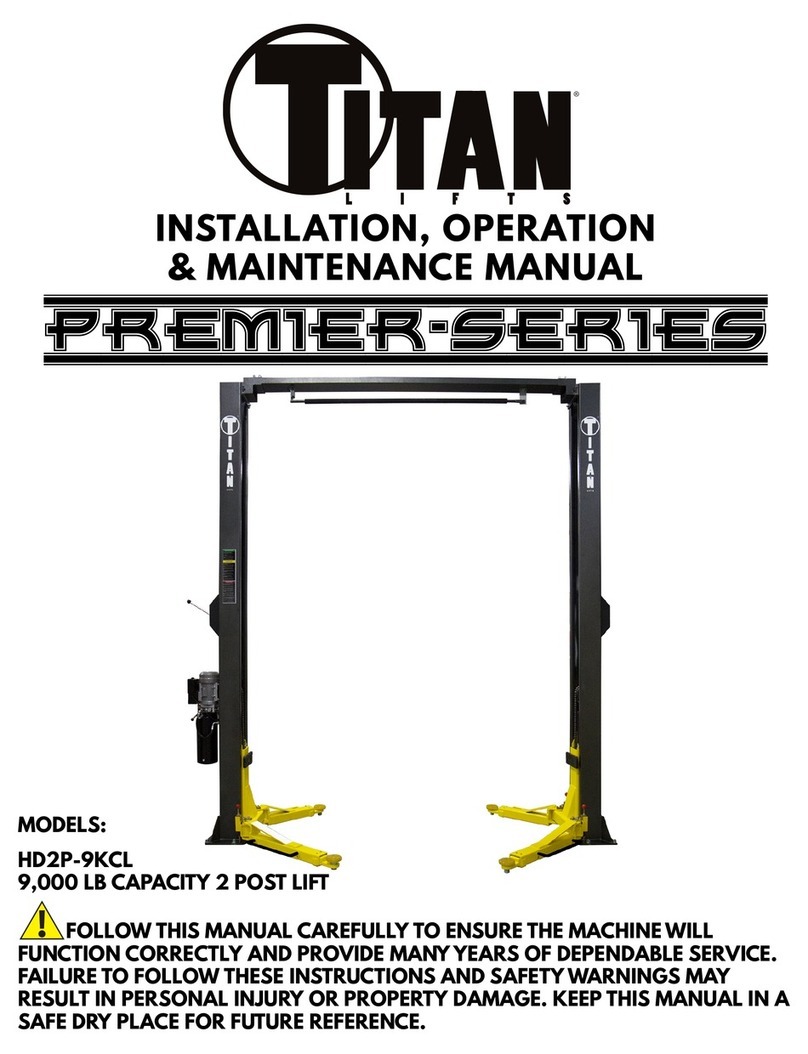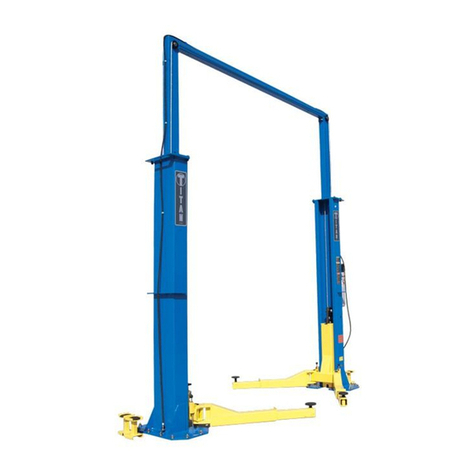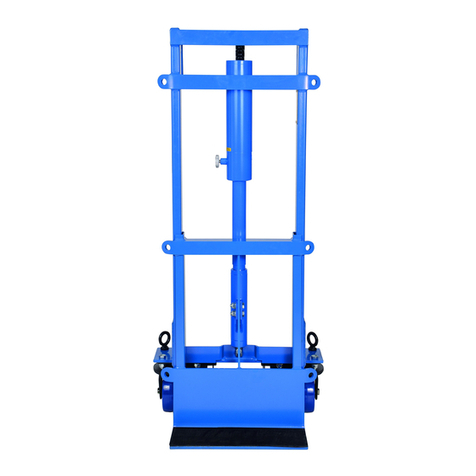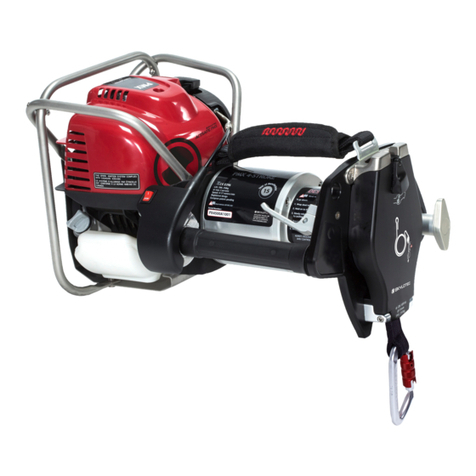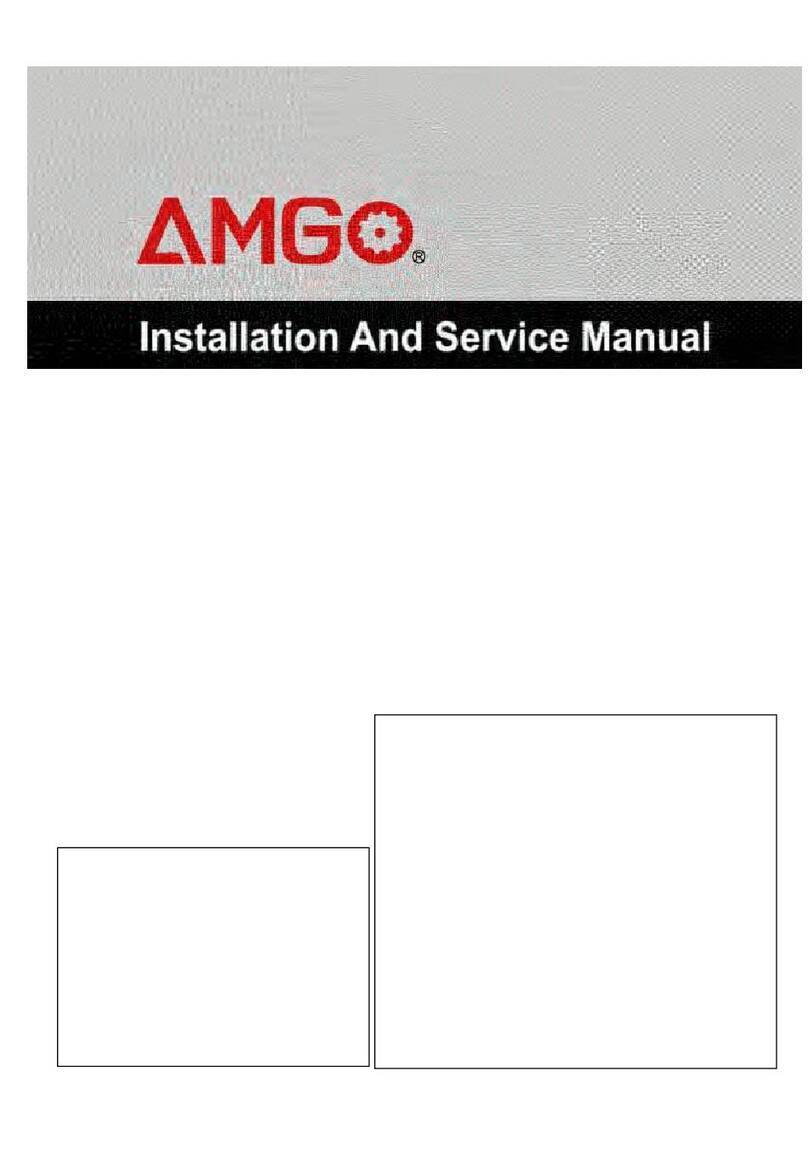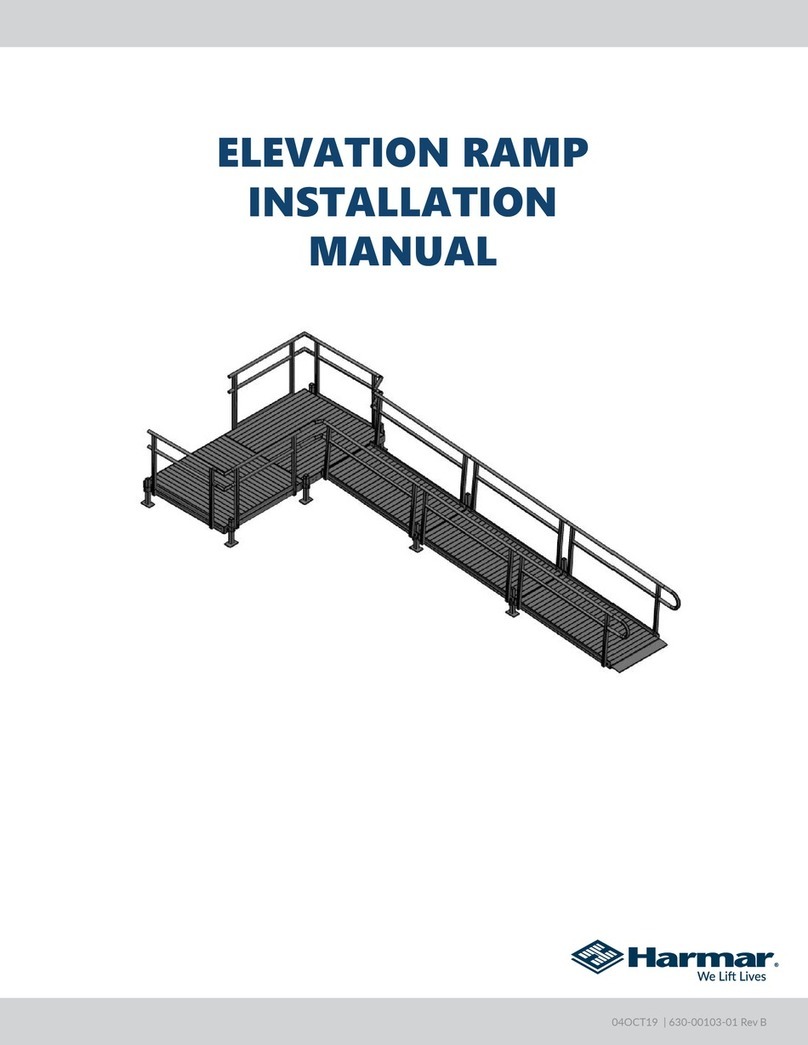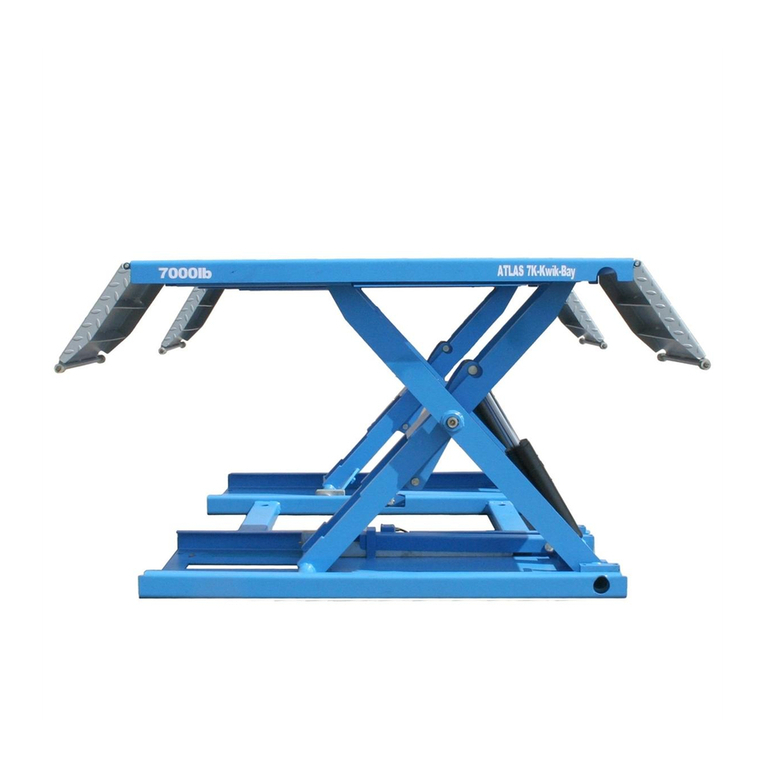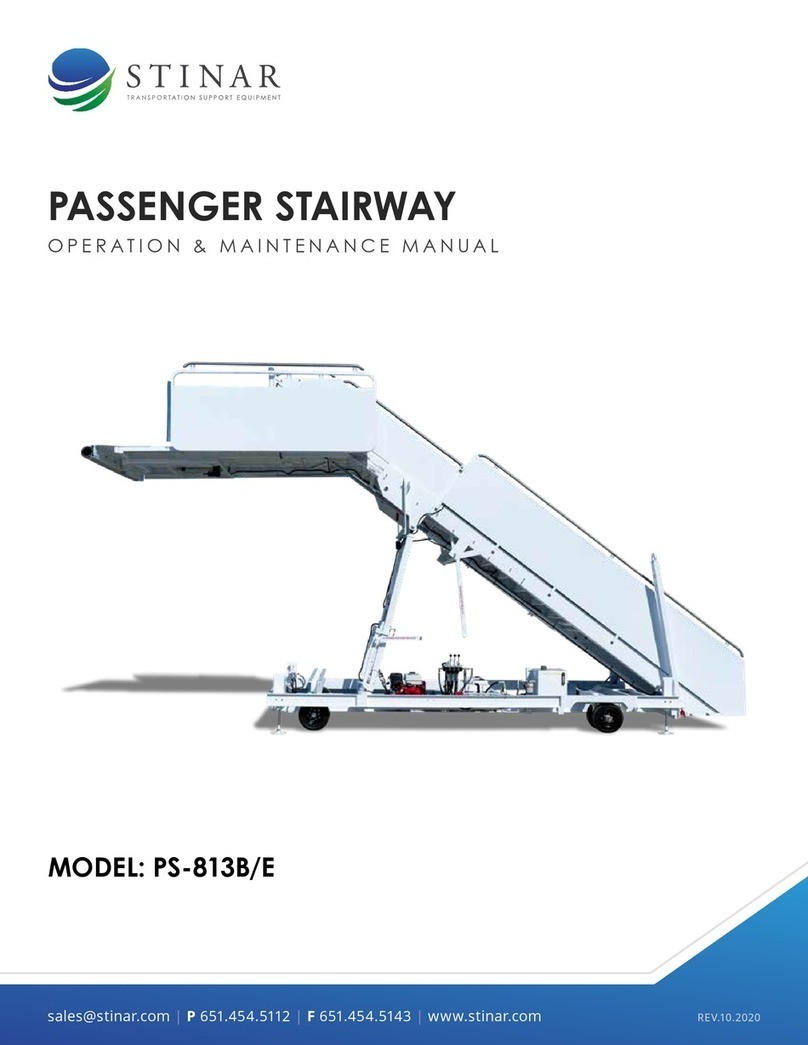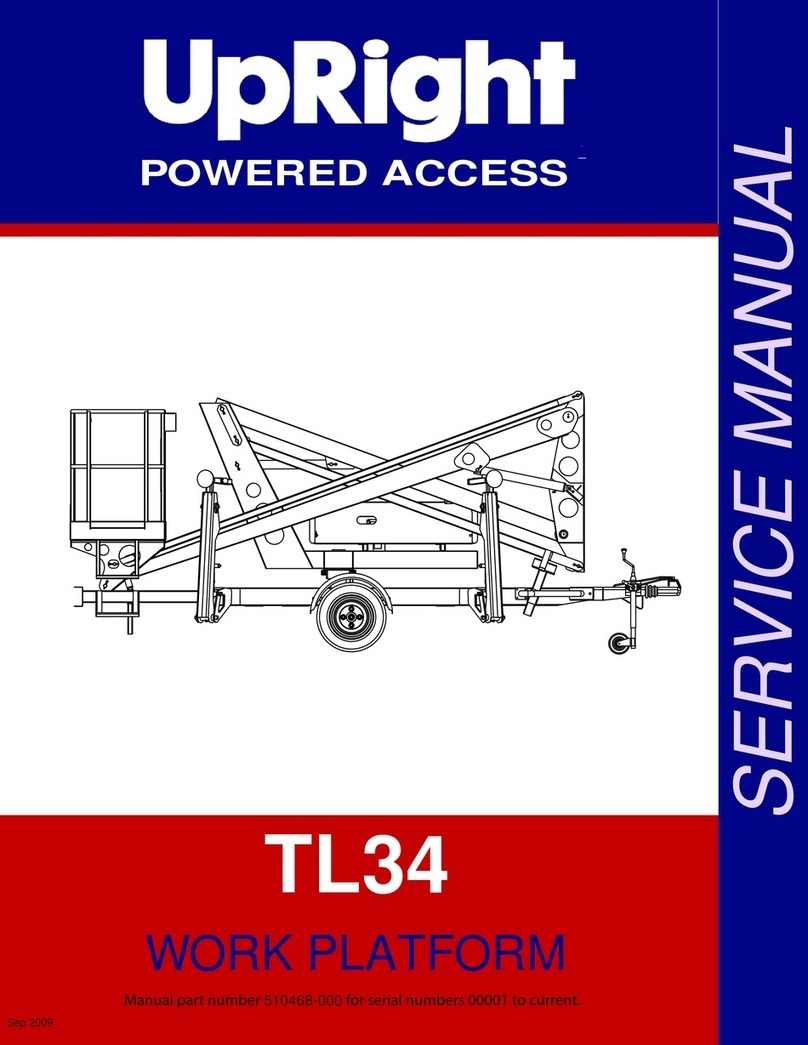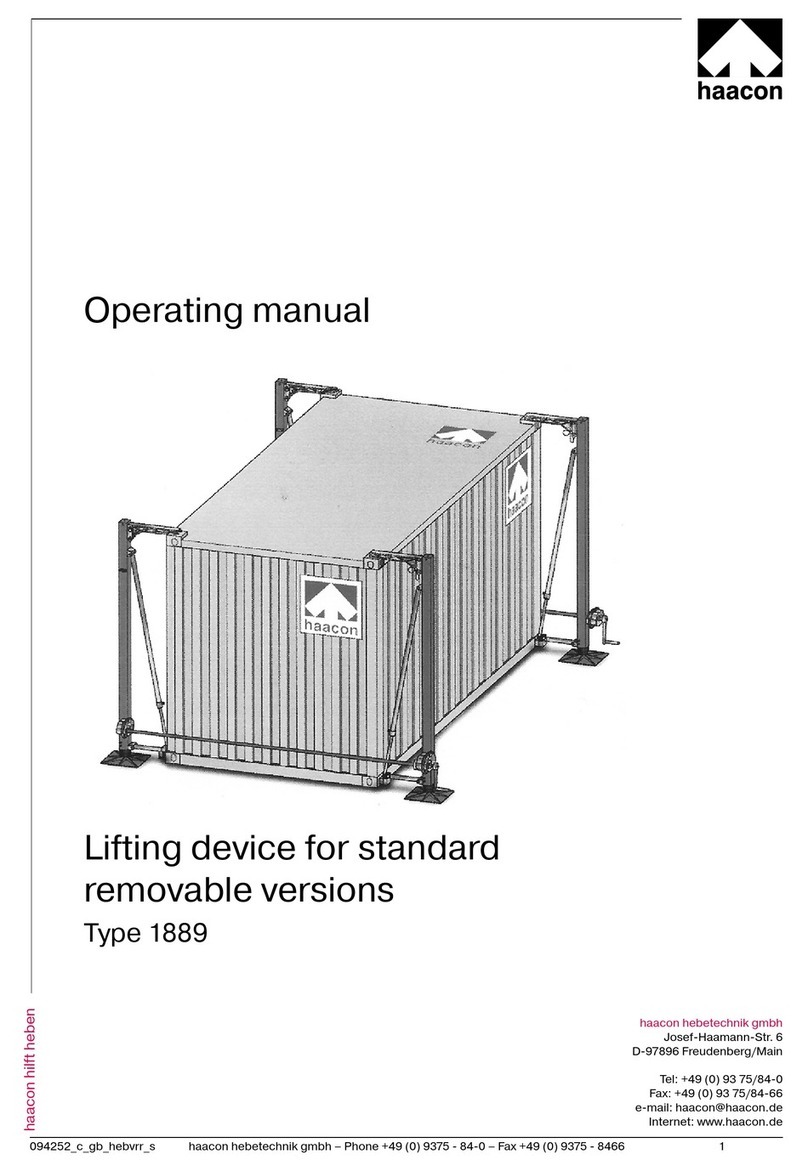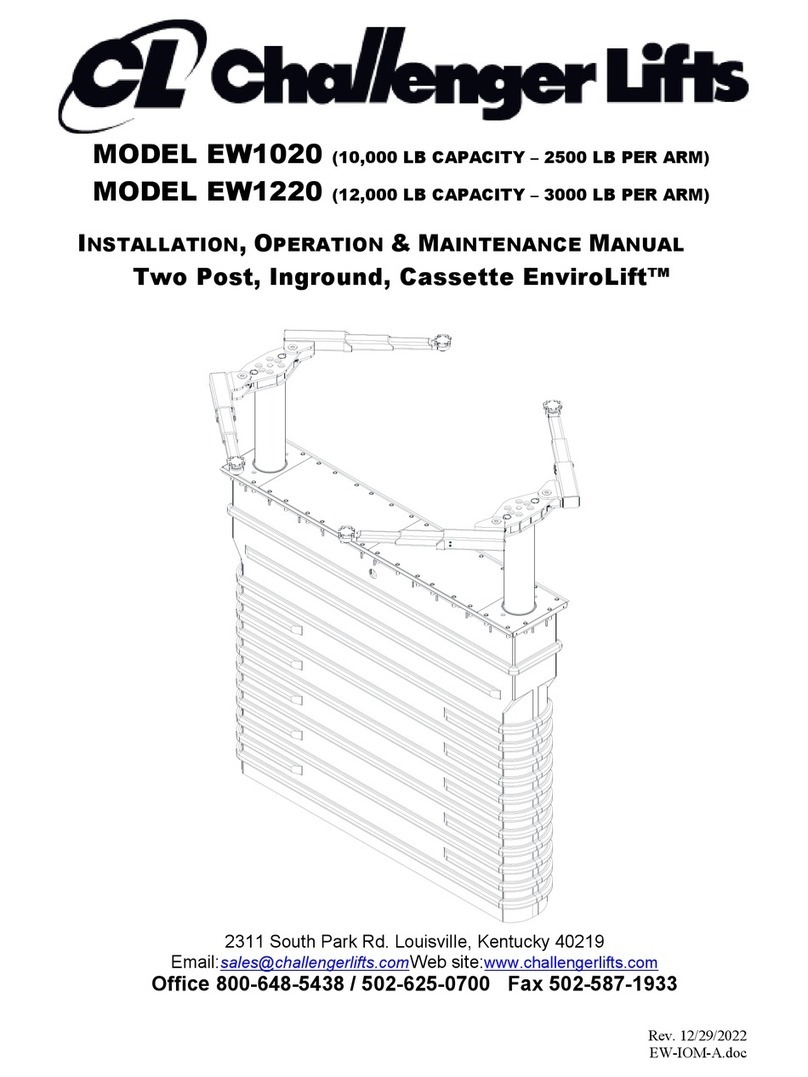Titan Lifts PREMIER HD2P-9KFP Instruction manual

INSTALLATION, OPERATION
& MAINTENANCE MANUAL
FOLLOW THIS MANUAL CAREFULLY TO ENSURE THE MACHINEWILL
FUNCTION CORRECTLY AND PROVIDE MANYYEARS OF DEPENDABLE SERVICE.
FAILURE TO FOLLOW THESE INSTRUCTIONS AND SAFETYWARNINGS MAY
RESULT IN PERSONAL INJURY OR PROPERTY DAMAGE. KEEP THIS MANUAL IN A
SAFE DRY PLACE FOR FUTURE REFERENCE.
MODELS:
HD2P-9KFP
9,000 LB CAPACITY 2 POST LIFT
®

Products May Be
UpgradedWithout Notice
PleaseVisit
WWW.TITANLIFTS.COM
For The LatestVersion Of
This Manual
P.O. Box 7069 • Greenwood, IN 46142 • Ph. 888-908-4826 • Fx. 317-215-2770 • www.titanlifts.com

PO Box 7069 Greenwood, IN 46142
1.888.908-4826 FAX (317) 215.2770
www.titanlifts.com
TITAN MARKETING, LLC
®
To Our Valued Customers:
Thank you for purchasing a Titan Lifts®product. We hope this high quality equipment provides you with years of
dependable service.
It is unfortunate that rare situations may occur with the products you purchase from Titan Lifts®. We value your
business as well as the trust you have and need to maintain your relationship with us. Titan Lifts®carries liability
coverage that may protect our customers if a situation does occur. However, as in all accidents there must be
proof of liability for a claim to be made. Our insurance company requires the following procedures be observed in
order to consider a claim:
A. The claimant must contact the Titan Lifts®distributor immediately with the facts of the situation.
B. If any equipment is damaged, including vehicles or shop equipment, Titan Lifts®must be given the
opportunity to send an impartial representative to the site for proper assessment of the situation.
C. The Vehicle cannot be moved until either an impartial representative has reviewed the accident or clear
and precise pictures are taken that reect all the pertinent information for an impartial representative to be able
to access the information from a distance. Titan Lifts®or its representatives must approve the pictures before
anything can be moved.
D. If any potential liability is determined on behalf of Titan Lifts®, two estimates must be submitted for
damages to be reimbursed.
It is imperative that the claimant complies with these procedures, because without proper assessment of the
situation a claim will be denied.
ARBITRATION NOTICE
The installation or use of this equipment shall constitute an acknowledgment that the user agrees to resolve any
and all disputes or claims of any kind whatsoever, which relate in any way to the equipment, by way of binding
arbitration, not litigation. No suit or legal action may be led in any state or federal court. Any arbitration shall be
governed by the Federal Arbitration Act, and administered by the American Mediation Association, Indianapolis
Indiana. The maximum amount that an arbitrator may award and all damages shall not exceed the retail value of
this equipment.
WARRANTY NOTICE
This equipment must be assembled and used in the manner according to the documentation provided to be
covered by warranty.
Damaged or missing components must be reported within 72 hours of receipt to your freight carrier and to the
distributor. Claims must be led to cover cost.
If you have any questions or if we can be of any further assistance, please don’t hesitate to contact a Titan Lifts®
representative at 1-888-908-4826. Thank you for the opportunity to continue to serve your lift equipment needs.

TABLE OF CONTENTS
1-SAFETY���������������������������������������������������������������������������������������������������������������� PAGE 1
1�1 INTRODUCTION �������������������������������������������������������������������������������������������������������������������PAGE 1
1�2 SAFETY INSTRUCTIONS FOR COMMISSIONING����������������������������������������������������������������PAGE 1
1�3 SAFETY INSTRUCTIONS FOR OPERATION �������������������������������������������������������������������������PAGE 1
1�4 SAFETY INSTRUCTIONS FOR MAINTENANCE �������������������������������������������������������������������PAGE 3
1�5 RISKS �����������������������������������������������������������������������������������������������������������������������������������PAGE 3
2-DESCRIPTION ������������������������������������������������������������������������������������������������������ PAGE 4
3-UNPACKING & SETUP������������������������������������������������������������������������������������������ PAGE 5
3�1 DELIVERY AND CHECK OF PACKAGES��������������������������������������������������������������������������������PAGE 5
3�2 LIFTING AND HANDLING�����������������������������������������������������������������������������������������������������PAGE 5
3�3 PREPARATION ���������������������������������������������������������������������������������������������������������������������PAGE 5
4-SPECIFICATIONS������������������������������������������������������������������������������������������������� PAGE 6
5-FLOOR REQUIREMENTS �������������������������������������������������������������������������������������� PAGE 6
5�1 SELECTING THE SITE AREA ������������������������������������������������������������������������������������������������PAGE 6
5�2 FLOOR REQUIREMENTS�������������������������������������������������������������������������������������������������������PAGE 6
5�3 IMPORTANT CONCRETE AND ANCHORING INFORMATION�����������������������������������������������PAGE 7
5�4 ANCHORING TIP SHEET ������������������������������������������������������������������������������������������������������PAGE 7
6-INSTALLATION INSTRUCTIONS ������������������������������������������������������������������������� PAGE 8
7-OPERATION INSTRUCTIONS����������������������������������������������������������������������������� PAGE 12
7�1 DEFECTS / MALFUNCTIONS����������������������������������������������������������������������������������������������PAGE 12
7�2 CONTROLS�������������������������������������������������������������������������������������������������������������������������PAGE 12
7.2.3 LOWERING CONTROL ................................................................................................................................................ PAGE 13
7�3 OPERATION������������������������������������������������������������������������������������������������������������������������PAGE 13
8-MAINTENANCE�������������������������������������������������������������������������������������������������� PAGE 15
8�1 MAINTENANCE SCHEDULE �����������������������������������������������������������������������������������������������PAGE 15
8.1.1 DAILY ............................................................................................................................................................................ PAGE 15
8.1.2 WEEKLY ........................................................................................................................................................................ PAGE 15
8.1.3 MONTHLY..................................................................................................................................................................... PAGE 16
8.1.4 BI-MONTHLY................................................................................................................................................................ PAGE 16
8.1.5 YEARLY ......................................................................................................................................................................... PAGE 16
8.1.6 EVERY OTHER YEAR................................................................................................................................................... PAGE 16
8�2 MAINTENANCE BY OPERATOR �����������������������������������������������������������������������������������������PAGE 17
8.2.1 HYDRAULIC SYSTEM ................................................................................................................................................. PAGE 17
8.2.2 GREASING POINTS..................................................................................................................................................... PAGE 17
8.2.3 OPERATION AND WEAR CHECKS ............................................................................................................................ PAGE 18
8�3 CLEANING ��������������������������������������������������������������������������������������������������������������������������PAGE 18
9-TROUBLESHOOTING ����������������������������������������������������������������������������������������� PAGE 19
10-OWNER/EMPLOYER RESPONSIBILITIES �������������������������������������������������������� PAGE 20
11-DIAGRAMS (FIG� 1-9)��������������������������������������������������������������������������������������� PAGE 21
FIG� 1 - HD2P-9KFP������������������������������������������������������������������������������������������������������������������PAGE 21
FIG� 2 - HD2P-9KFP������������������������������������������������������������������������������������������������������������������PAGE 22
FIG� 3 - HD2P-9KFP������������������������������������������������������������������������������������������������������������������PAGE 23
FIG� 4 - POWER UNIT ���������������������������������������������������������������������������������������������������������������PAGE 24
FIG� 5 - MAIN COLUMN������������������������������������������������������������������������������������������������������������PAGE 25
FIG� 6 - OFFSIDE COLUMN�������������������������������������������������������������������������������������������������������PAGE 26
FIG� 7 - MAIN SIDE CARRIAGE�������������������������������������������������������������������������������������������������PAGE 27
FIG� 8 - OFFSIDE CARRIAGE ����������������������������������������������������������������������������������������������������PAGE 28
FIG� 9 - CABLES & HOSES��������������������������������������������������������������������������������������������������������PAGE 29
PARTS LIST������������������������������������������������������������������������������������������������������������������������������PAGE 30

1
1-SAFETY
INSTRUCTIONS
1.1 INTRODUCTION
• The lift may be installed and commissioned by authorized service personnel only.
• The standard lift version may not be installed and commissioned in the vicinity of
explosives or ammable liquids, outdoors or in moist rooms (e.g. car wash).
• Read this entire manual.
• Load should not exceed rated capacity for this lift – 9,000 lb (2,250 lb per lift arm)
• Only trained authorized personnel over the age of 18 years should operate the lift.
• Indoor use recommended.
• Always lift the vehicle using all four arms.
• Never use the lift to raise one end or one side of vehicle.
FAILURE TO COMPLY WITH INSTRUCTIONS COULD RESULT IN
PROPERTY DAMAGE.
WARNING: READ ENTIRE MANUAL AND COMPLY WITH ALL SAFETY AND SERVICE
PRECAUTIONS. DEATH, PERSONAL INJURY AND / OR PROPERTY DAMAGE MAY OCCUR IF
INSTRUCTIONS ARE NOT FOLLOWED CAREFULLY.
Personal injury and property damage incurred due to non-compliance with these safety
instructions are not covered by the product liability regulations.
FAILURE TO COMPLY WITH INSTRUCTIONS COULD RESULT IN PERSONAL
INJURY.
SYMBOLS
IMPORTANT INFORMATION
1.2 SAFETY INSTRUCTIONS FOR COMMISSIONING
1.3 SAFETY INSTRUCTIONS FOR OPERATION

2
WARNING: Prior to completely raising the vehicle, raise the vehicle 6” off the ground
and check the adapter pads for solid contact by performing the “BUMPER TEST”. Walk
around the back of the vehicle and push up and down on the bumper. The vehicle will rock,
but should not at any time lose contact with the pads. If the vehicle is bouncing off the pads
or feels at all unstable, you should lower it back to the ground and reposition the pads to
balance the load. Repeat this process until the vehicle is completely stable.
WARNING: Use this lift only in well ventilated areas. Carbon monoxide exhausted from
running vehicle engines is a colorless, odorless fume that, if inhaled, can cause serious
personal injury or death.
WARNING: People with pacemakers should consult their physician(s) before using this
product. Operation of electrical equipment in close proximity to a heart pacemaker could
cause interference or failure of the pacemaker.
WARNING: This product contains or produces a chemical known to the State of
California to cause cancer and birth defects (or other reproductive harm). (California Health
& Safety Code 25249.5 et seq.)
• Maintain a safe working environment. The work area should be clean, dry, clutter free, and
sufciently lit.
• Vehicle doors should be closed during the raising and lowering cycles.
• Closely watch the vehicle and lift during the raising and lowering cycles.
• Do not operate the lift in explosive atmospheres, such as in the presence of ammable
liquids, gases, or dust. Power equipment can create sparks which may ignite ammables.
• Keep hands, tools, and other extremities from under carriage and moving parts.
• Never operate this lift with someone on it.
• Do not allow anyone on the lift or inside a raised vehicle.
• Keep children and bystanders away from work area. Do not let children operate or play on
lift.
• Wear proper safety attire. Do not wear loose tting clothing while operating lift. Long hair,
jewelry and sleeves should be secured.
• Never leave the lift unattended while under a load.
• Do not operate this lift if under the inuence of drugs, alcohol, or medication. Operator
must be alert at all times when using heavy lift equipment.
• Comply with all applicable accident prevention regulations.
• Only use the vehicle manufacturer’s recommended lifting points.
• After positioning the vehicle, apply the parking brake.
• Use caution when removing or installing heavy vehicle components which may result in
center-of-gravity displacement.
• Use this lift only for the work it is intended. Do not use this product for an application for
which it was not designed. Misuse can lead to personal injury and/or property damage.

3
WARNING: Risks the personnel could encounter, due to an improper use of the lift, are
described in this section.
CRUSHING RISK
During lowering of runways and vehicles, personnel must not be within the area covered by
the lowering trajectory. The operator must be sure no one is in danger before operating the
lift. Stay clear of the lift when lowering or raising vehicles. Keep hands and feet away from
moving parts and especially points that could pinch. Keep your feet clear of the lift when
raising and lowering vehicles.
RISK OF THE VEHICLE FALLING FROM THE LIFT
Risk of the vehicle falling from the lift is increased: when the vehicle is improperly placed on
the platforms, when the vehicle’s weight or physical dimensions exceed the rated capacity
of the lift, or when there is excessive movement of the vehicle while on the lift. If vehicle
appears to begin falling, exit the area as quickly as possible to avoid injury. Always position
vehicle with the center of gravity midway between the adapters. Adding or removing parts of
a vehicle on the lift will alter the weight displacement on the lift. Therefore, use of auxiliary
safety stands in the front and back of the vehicle is recommended. Never override the
manufactured lift controls. Always use height adapter pads when possible to ensure proper
contact. Only authorized personnel should be allowed in the lift area and the lift should only
be operated by authorized and trained personnel. Adding or removing parts of a vehicle on
the lift will alter the weight displacement on the lift.
BUMPING RISK
When the lift is stopped at relatively low working height, the risk of bumping against
projecting parts increases. Always be aware of your surroundings and avoid bumping your
head or body on the lift or the vehicle.
1.4 SAFETY INSTRUCTIONS FOR MAINTENANCE
1.5 RISKS
• Maintenance or repair work should be done by authorized service personnel only.
• Work on the electrical equipment should be done by certied licensed electricians only.
• Ensure that ecologically harmful substances are disposed of in accordance with the
appropriate regulations.
• To prevent the risk of damage, do not use high pressure / steam jet cleaners or caustic
cleaning agents.
• Do not replace or override the safety devices.

4
The following is a 2-Column hydraulic, leaf chain driven lift.
The model numbers covered in this manual are designated below:
HD2P-9KFP: 2-Column Floorplate Lift type, 9,000 lb Capacity, Asymmetric
Swing Arm set up.
This lift is a 9,000 lb capacity, 2-Post Lift. The safety latch system is very similar to an
extension ladder. The safety latch is in contact with the rack as the lift ascends and drops
into place as the lift rises. Safety latch engages in rack in 3” increments at about 16” from
the ground. The latch must be manually disengaged for the lift to descend. The latch is
released by raising the latch rack using the hydraulic drive system and pulling the release
handle. If the user lets go of the manual release handle, the safety latch will re-engage on the
next lock latch it encounters. Heavy bearings and heavy-duty leaf chains are used throughout
the lift. The work is done with the heavy-duty chain connected to a 3” cylinder, driven by a
hydraulic pump capable of providing 3,000 psi.
Please read the Safety Procedures and operation instructions in this manual before
operating the lift. Proper installation is very important. To minimize the chance of making an
error in installation, please read this manual thoroughly before beginning installation. Check
with building owner and/or architect’s building plans when applicable. The lift should be
located on a level oor with 4” 3000 psi concrete sufciently cured, for at least 30 days.
This is a vehicle lift installation / operation manual and no attempt is made or implied herein
to instruct the user in lifting methods particular to an individual application. Rather, the
contents of this manual are intended as a basis for operation and maintenance of the unit
as it stands alone or as it is intended and anticipated to be used in conjunction with other
equipment.
Proper application of the equipment described herein is limited to the parameters detailed
in the specications and the uses set forth in the descriptive passages. Any other proposed
application of this equipment should be documented and submitted in writing to the factory
for examination. The user assumes full responsibility for any equipment damage, personal
injury, or alteration of the equipment described in this manual or any subsequent damages.
2-DESCRIPTION

5
3-UNPACKING & SETUP
Only skilled personnel who are familiar with the lift and this manual shall be allowed to carry
out, lifting, handling, transport and unpacking operations.
When the lift is delivered, carefully unpack the lift making sure all the parts have been
included. Check for possible damages due to transport and storage; verify that what is
specied in the conrmation of order is included. In case of damage in transit, the customer
must immediately inform the carrier of the problem.
Remove the lift and all parts from delivery pallet and place on a clean, solid, at surface.
Packages must be opened paying attention not to cause damage to people (keep a safe
distance when opening straps) and parts of the lift (be careful the objects do not drop from
the package when opening.)
LIFT AND HANDLE ONLY ONE PACKAGE AT A TIME
3.1 DELIVERY AND CHECK OF PACKAGES
3.2 LIFTING AND HANDLING
3.3 PREPARATION
When loading/unloading or transporting the equipment to the site, be sure to use suitable
loading (e.g. cranes, trucks) and hoisting means. Be sure to hoist and transport the
components securely so that they cannot drop, taking into consideration the package’s size,
weight, center of gravity, and its fragile parts.
Professional installation is required. The following tools and equipment are needed:
1. ISO-32, AW-32, or AW-46 hydraulic oil (2.5 Gallons)
2. Chalk line and Tape Measure
3. Rotary Hammer Drill with 3/4” Drill Bit. Core Drill Rebar Cutter recommended
4. 4’ Level
5. Sockets and Open Wrench set, metric & standard (1-1/8”for 3/4” Anchors)
6. Pliers
7. Torque Wrench
8. Metric allen wrench set

6
*Carriage lock ladder will extend 11” above top of column when raised to max height.*
4-SPECIFICATIONS
Model Description Capacity Lifting Time *Column Height Overall Width Between Posts
HD2P-9KFP Floorplate/
Asymmetric 9,000 lb 40-60 sec. 111.25” 134.75” 112.25”
Drive-Thru
103.25”
5-FLOOR REQUIREMENTS
WARNING: SPECIFICATIONS OF CONCRETE MUST BE ADHERED TO. FAILURE
TO DO SO COULD CAUSE LIFT FAILURE RESULTING IN PERSONAL INJURY OR
DEATH. THE FLOOR SHOULD BE A REINFORCED CONCRETE SLAB NOT LESS
THAN 4” THICKWITH THE COMPRESSIVE STRENGTH OF THE CONCRETE NO LESS
THAN 3,000 PSI.
DANGER: FOR CORRECT INSTALLATION OF THE LIFT, THE FLOOR MUST
BE FLAT AND LEVEL. CHECKWITH STRAIGHT EDGE AND LEVEL. IF A FLOOR IS
OF QUESTIONABLE SLOPE, CONSIDER A SURVEY OF THE SITE AND/OR THE
POSSIBILITY OF POURING A NEW LEVEL CONCRETE SLAB.
5.1 SELECTING THE SITE AREA
5.2 FLOOR REQUIREMENTS
1. Make sure that adequate space and height is available.
2. Check for ceiling clearance (lifting height plus vehicle height).
3. Check for clearance in front and rear of vehicle on lift.
4. Check for overhead garage door clearance.
Do not use the lift on any asphalt surface. Make sure the lift is used on a dry, oil/grease free,
at level CONCRETE surface capable of supporting the weight of the lift, the vehicle being
lifted, and any additional tools and equipment. The concrete oor surface should have a
minimum thickness of 4”. The concrete must have a minimum strength of 3,000 PSI, and
should be cured at least 30 days prior to use. Do not use the lift on concrete expansion
seams or on cracked, defective concrete.
IMPORTANT: NEW CONCRETE MUST BE ADEQUATELY CURED AT LEAST 30
DAYS MINIMUM. NO LIABILITY FOR ANY DAMAGES WILL BE ACCEPTED SHOULD
YOU INSTALL THE LIFT ON AN UNSUITABLE FLOOR.
Due to minor variances in the manufacturing process, dimensions in this manual may vary slightly
from the nished product.

7
5.3 IMPORTANT CONCRETE AND ANCHORING INFORMATION
1. Concrete shall have compression strength of at least 3,000 PSI and a minimum thickness of
4”. Measure the length of the supplied anchor bolts in order to achieve a minimum anchor
embedment of 3-1/4”. If the top of the anchor exceeds 2” above the oor grade, you DO NOT
have enough embedment.
2. Before drilling 3/4” dia. Holes in concrete oor using holes in column base plate as guide, make
sure the hole distance from the edge of the concrete or any cracks is no less than 8”.
3. DANGER: DO NOT Install on asphalt or other similar unstable surface. Columns are
supported only by anchoring in oor.
4. Shim each column base until each column is plumb. If one column has to be elevated to match
the plane of the other column, full size base shim plates should be used (Reference Shim Kit).
Torque anchors to 85 ft-lbs. Shim thickness MUST NOT exceed 1/2”.
5. If anchors do not tighten to 85 ft-lbs installation torque, replace concrete under each column
base with a 4’ x 4’ x 12” thick 3,000 PSI minimum concrete pad pinned to the existing concrete
and ush with the top of existing oor. Let concrete cure at least 30 days before installing lifts
and anchors.
5.4 ANCHORING TIP SHEET
1. Use a concrete hammer drill with a carbide tip, solid drill bit the same diameter as the anchor,
3/4”. (.775 to .787 inches diameter). Do not use excessively worn bits or bits which have been
incorrectly sharpened.
2. Keep the drill perpendicular to the concrete while drilling.
3. Let the drill do the work. Do not apply excessive pressure. Lift the drill up and down occasionally
to remove residue to reduce binding.
4. Drill the hole for anchor bolt completely through the concrete. If an error is made during the
installation of these anchors, this will allow for the anchor bolt to be driven down into the
ground, so that a new anchor may be installed in place (g.1).
5. Be sure to clean all dust from hole (g. 2).
6. Place a at washer and hex nut over threaded end of anchor, leaving approximately 1/4 inch of
thread exposed above the nut (g.3). Carefully tap anchor into the concrete until nut and at
washer are against base plate. Be sure to only tap the top of the anchor and not the nut. This
could cause damage to the threads of the anchor.
7. Tighten the nut (g. 4) to 85 ft-lbs of torque (typically this should only be two to three full turns).
DO NOT USE AN IMPACTWRENCH TO TIGHTEN ANCHORS!

8
1) After unloading the lift, place it near the intended
installation location.
2) Remove the shipping bands and protective wrapping
from the lift. Support the top column as you remove the
packing frames from each end of the lift. Be sure to set
the columns down onto a block of wood to avoid any
damage.
3) Remove all loose components from the lift columns and
set aside. This is a good time to tighten the top plates
of the columns if needed and check the contents of the
parts box to ensure that you have all the components
needed to complete this install.
4) Once you determine where you want to install the lift, check to make sure there are no
obstructions in the ceiling that may interfere when standing the columns up. If clear, go
ahead and stand the columns up at his time.
5) Position the columns facing each other 134.75” from the outside
of the base plates; then install the locking system components into
each column (refer to pictures). Be sure to secure the ends of the lock
spindle with the provided C-Clips. Once installed, raise each carriage to
the rst safety lock. NOTE: The power unit column is referred to as the
main side column and the non-power unit column is referred to as the
offside column.
6) Once one of the lift columns is positioned, using a 3/4” concrete drill
bit, drill the anchor bolt holes through the baseplate of the column,
installing anchors as you go. Thread the nut to the top of anchor and
carefully tap them into the holes drilled into the concrete.
7) Using a level, check column for side-to-side plumb and front-to-back
plumb. It is very important that the columns are perfectly plumb in
both directions. Failure to do this could result in premature wear on the
lifting components and/or pad movement while lifting a vehicle. Use
the provided shims to shim the lift column as needed by placing them
around the anchor. Once the column is perfectly plumb, torque 3/4”
anchor bolts to 85 ft-lbs using a torque wrench NOTE: DO NOT USE
IMPACT WRENCH.
6-INSTALLATION INSTRUCTIONS
PLEASE NOTE THAT ALL DIMENSIONS GIVEN ARE FOR REFERENCE. FINAL
DIMENSIONS MAY VARY SLIGHTLY. LIFT COLUMNS MUST BE PLUMB AND
SQUARE REGARDLESS OF FINAL DIMENSIONS.
MAIN SIDE
OFFSIDE

9
8) Using a tape measure, measure diagonally from the face of one column to the opposite
face of the other, to ensure that the columns are square (see below). After conrming
the dimensions, test t the oor plate AND hydraulic hose BEFORE drilling the anchors
for the offside column. This will help you determine if you have the columns spaced
properly, prior to drilling the second column. Drill the anchor bolt holes in the column,
installing anchors as you go. Check front to back and side to side plumb before
torqueing anchors to 85 ft-lbs. Again, it is extremely important that these columns are
perfectly plumb in both directions. Use shims to plumb columns as needed.
9) In order to operate both lock latches from the power unit column, you
will need to install the safety release cable. Start by loosening the bolt
in the side of the lock mechanism on the offside column and insert the
cable though the hole about 6-10” of excess cable coming out. Snug
the pinch bolt to secure the cable in place. Route the other end of the
cable in between the (2) pulleys below the lock and feed it down the
column, behind the carriage until it can be routed around the pulley that
is attached to the baseplate of the column. Continue to route the cable
over to the opposite column, around the pulley at the baseplate of the
column, then up the inside of the column, behind the carriage, until it
can be routed around the top of the small pulley on the power unit side
of the lift. (Tip: run a piece of string down the inside of the column and
attach the cable so that you can easily pull the cable up, behind the
carriage.) Loosen the bolt in the side of the lock mechanism on the
power unit side column and feed the rest of the cable though the lock
and pull all slack from the cable prior to snugging the pinch bolt back
up. You can also install the safety lock release handle to the Main Side
column but set the ball handle aside for later in the installation.
10) You are now ready to install the equalizing cables: Route cables
through carriages and around pulleys as shown in diagram. Secure
cables to the carriage using one of the two supplied cable nuts on
each end of the cable. (The second nut will be used as a jam nut after
nal adjustments are made to cable.) (Tip: When installing the cables, loosen the nut on
the cable that is pointing upward inside each carriage until the end of the stud is ush
with the just one nut. Then to take up slack in the cables, pull down on the cable that is
pointing downward inside each carriage and hand tightening cable nut. This will take all
the slack out of the cable, leaving your adjustments to be made from the easier to reach
cable nut. Tighten the nut on the cable that’s pointing up-ward until ½” to ¾” is sticking
out past the single nut.)
MAIN SIDE
OFFSIDE

10
Use 5/8” wrench to
tighten the nut.
WARNING: The wiring must comply with local code. Have a certied licensed
electrician make the electrical hook-up to the power unit. Protect each circuit with time delay
fuse or circuit breaker 208v.230v single Phase. 60Hz 30 Amp.
11) Properly route and install the hydraulic hose, then place the hose cover on top. The hose
cover may be anchored to the concrete using the supplied anchors, however, this step is
not required.
12) Install the oor-plate to the base of the columns using the (4) supplied cap head bolts
and washers.
13) Install the power unit to the main side column using the supplied bolts, washers, and
nuts. Install short hose to make the connection between the hydraulic hose tting on
the cylinder and the hydraulic tting on the power unit. NOTE: Hydraulic tting that is
supplied with the power-unit may need to be moved to the port on the opposite side of
the valve body on certain lift models. It is REQUIRED that a licensed electrician make the
electrical hookup to the power unit. NOTE: The electrical test lead that is connected to
the motor is strictly for PRELIMINARY LIFT TESTING AND ADJUSTING ONLY.
14) Install the lifting arms and arm restraint pins. The easiest way to install these is to
remove the cotter pin, washer, and spring, then drop them into the bracket from the top.
Reinstall the spring, washer, and cotter pin after the pin is in place. (Tip: Before installing
the arm restraint pins, remove the ball handles from the pins and spin the treaded plates
down until the top of the gear block is 3 ¼” from the top of the threaded pin.)Adjust the
arm lock gear and the arm lock until they mesh, then tighten the nut of the arm lock.
Bottom
Cable Sheave
Top Cable
Sheave
Equalizing
Cable*2
Carriage
Locking
Nuts*4

11
15) To adjust the arm lock, loosen the arm restraint gear on each arm and push them into
the arm lock block until the mesh completely, then tighten the bolts on the arm restraint
gear. Next tighten the nut on the top of the arm lock block until it’s snug. Once that’s
done, you can thread the ball handles to the arm
restraint pins.
16) Prior to using the lift, it’s important that all (4)
inside corners of each column get greased from
top to bottom. Failure to do this will result in
premature wear of the nylon slide blocks and
could even cause the lift to bind while in use.
17) Fill power unit reservoir with (10) quarts (2.5
gal) of premium quality ISO-32, AW-32, or AW-46
hydraulic oil only. Be sure to periodically check
dipstick to prevent spillage. NOTE: This is a good
time to check if all ttings on the lift are tightened properly.
18) Press and hold power button on motor to operate lift. Raise carriages all the way to the
top of the lift, then lower carriages down to the ground to bleed air from the hydraulic
system prior to adjusting cable tension. NOTE: Cables must be adjusted so that the
safety locks engage simultaneously prior to lifting any weight. In order to adjust the
cables properly, you will need to raise the lift to determine which side is engaging into
the lock latches rst. Whichever side is higher, tighten the nut on the cable end pointing
upward in the carriage to raise the other side that is trailing behind. When the lift is
properly adjusted, the locks will engage together and you will hear only one click.
19) Once all adjustments are nished, you can install the lock covers
on each side of the column using the (8) supplied cap head
bolts and washers. Also, don’t forget to install the truck adapter
mounting brackets on each column as well as installing the black
“toe guards” onto each arm, while you are nishing up.
WARNING: DO NOT PERFORM ANY MAINTENANCE OR INSTALLATION OF ANY
COMPONENTS WITHOUT FIRST ENSURING THAT ELECTRICAL POWER HAS BEEN
DISCONNECTED AT THE SOURCE OR PANEL AND CANNOT BE REENERGIZED UNTIL ALL
MAINTENANCE AND/OR INSTALLATION PROCEDURES ARE COMPLETED.
DANGER: DO NOT RUN POWER UNIT WITHOUT FLUID. DAMAGE TO PUMP CAN OCCUR.
THE POWER UNIT MUST BE KEPT DRY. DAMAGE TO POWER UNIT CAUSED BY WATER OR
OTHER LIQUIDS SUCH AS DETERGENTS, ACID ETC., IS NOT COVERED UNDER WARRANTY.
Tighten the nut.
Arm lock
Arm lock gear
WARNING: WHEN RAISING THE LIFT ALL THEWAY UP FOR THE FIRST TIME, BE SURE
THAT YOU ARE CHECKING FOR CLEARANCE BETWEEN THE LOCK LADDER ON THE CARRIAGE
AND THE PULLEY THAT’S FIXED TO THE TOP PLATE OF THE COLUMN. IF THERE ISN’T ENOUGH
CLEARANCE BETWEEN THESE 2 PARTS, YOU WILL NEED TO LOOSEN UP THE 4 BOLTS AT THE
TOP OF EACH COLUMN AND SLIDE THE ENTIRE TOP CAP INWARD TO
THE CENTER OF THE LIFT. THISWILL ALLOW THE LOCK LADDERS OF THE
CARRIAGES TO PROPERLY PASS THROUGH THE TOP PLATES.

12
7-OPERATION INSTRUCTIONS
WARNING: LIFT OPERATION BY TRAINED AUTHORIZED PERSONNEL OVER
18YEARS ONLY. APPLY THE PARKING BRAKE AFTER POSITIONING THE VEHICLE
ON THE LIFT. DO NOT ALLOW ANYONE TO STAY IN LIFT AREA DURING RAISING
AND LOWERING CYCLES. CLOSELY WATCH THE VEHICLE AND THE LIFT DURING
RAISING AND LOWERING CYCLES. OBSERVE THE RATED LOAD CAPACITY AND
LOAD DISTRIBUTION. DO NOT ALLOW ANYONE TO CLIMB ON LIFT OR STAY
INSIDE VEHICLE. AFTER RAISING THE VEHICLE FRAME 6”, STOP AND CHECK
ADAPTERS FOR SECURE CONTACT. PERFORM BUMPER TEST(PG.2). MAKE SURE
THEVEHICLE DOORS ARE CLOSED DURING RAISING AND LOWERING CYCLES.
WARNING: IN CASE OF DEFECTS OR MALFUNCTIONS SUCH AS JERKY LIFT
MOVEMENT OR DEFORMATION OF THE SUPERSTRUCTURE, SUPPORT OR LOWER
THE LIFT IMMEDIATELY. CONTACT QUALIFIED SERVICE PERSONNEL.
WARNING: PAY CLOSE ATTENTIONWHEN SETTING THE LOCKS. THE LOCKS
MUST BE A LEVEL MATCH SET IN ORDER TO AVOID A VEHICLE TILT.
WARNING: ALWAYS LOCK THE LIFT BEFORE GOING UNDER THE VEHICLE.
NEVER ALLOW ANYONE TO GO UNDER THE LIFTWHEN RAISING OR LOWERING.
7.1 DEFECTS / MALFUNCTIONS
7.2 CONTROLS
7.2.1 UP CONTROL
7.2.2 SAFETY LOCK CONTROL
The safety latch mechanism will “Trip Over” as the lift raises and drop into each safety latch
stop. To lock the lift you must press the lowering handle on the power unit (Fig. 1) to relieve
the hydraulic pressure and let the safety locks engage into a level locked position.
Once the up button is actuated, the lift moves up until the button is
released or the limit stop is reached.
UP

13
1. Before driving a vehicle onto the lift make sure the lift is fully lowered. Before driving a
vehicle onto the lift, position the lift arms outward. Do not hit or run over the lifting arms,
as this could damage the vehicle and/or lift. Make sure the lift is fully lowered before
moving the vehicle over the lift. NOTE: It is recommended to swing both arms outward
pointing toward the front of the lift prior to loading a vehicle into the HD2P-9KFP.
2. Drive the vehicle over the lift while keeping the vehicle parallel with the lift and aligning
the center of gravity of the vehicle with the center of the lift. NOTE: The “Center of
Gravity” (COG) of the vehicle is the balance point at which there is equal weight in front
of and behind the COG, and equal weight on both sides of the COG. The COG is not
necessarily the dimensional center of the vehicle, but is often slightly toward the engine
from the dimensional center of the vehicle.
3. Turn off the vehicle’s engine and engage the parking brake of the vehicle.
4. Read the vehicles owner’s manual to identify the recommended vehicle lifting points.
5. Prepare the work area according to this manual. Move the lifting arms inward, and
position the rubber pads to contact with the vehicle manufacturer’s recommended lifting
points.
7.3 OPERATION
NOTE: IT IS NORMAL FOR AN EMPTY LIFT TO LOWER SLOWLY - IT MAY BE
NECESSARY TO ADDWEIGHT.
7.2.3 LOWERING CONTROL
WARNING: FAILURE TO OPERATE THE LIFT ACCORDING TO THIS MANUAL
MAY CAUSE DAMAGE TO THE LIFT, PROPERTY DAMAGE AND/OR PERSONAL
INJURY.
IMPORTANT: PLACE THE FOUR RUBBER PADS UNDER EDGE OF VEHICLE AT
THE FOUR JACK POINTS.
6. Once the lifting arms have been positioned under the vehicle lifting points, operate the
power switch to make contact and lift the vehicle slightly. Test to make sure the vehicle
is well balanced and the contact between the rubber pads and vehicle lifting points are
secure by performing the “BUMPER TEST.” (pg. 2) Then proceed to lift the vehicle to the
desired height.
Press the up button enough to allow the safety locks to be disengaged. Pull
the latch release handle (Fig. 1) to release the safety locks.
WARNING: ALWAYS ENSURE BOTH SIDES RELEASE.
Press the lowering handle (Pg. 17 Fig. 2) until the lift is completely lowered.
Fig. 1

14
7. WARNING: Do not lift the vehicle if you cannot establish secure and level lifting
points. Do not use sub-standard shims or other devices in place of approved and
recommended rubber pad adapters. Never use the lift without the rubber pads in place on
each plate and in contact with the lifting points of a vehicle.
8. Press up button and raise vehicle to desired height. Do not go under vehicle until load
rests on level safety locks.
9. While lifting the vehicle a clicking sound should be noticeable which indicates the safety
mechanism is operating. If this sound is not heard, immediately cease using the lift and
call an authorized service agent.
10. When lift reaches maximum height, a limit switch will come into operation and stop the
lift. When lift has stopped, press and hold the lowering handle (Fig. 1) until load rests on
level safety locks.
11. Once the repair work to the vehicle is complete, make sure to remove all tools, safety jack
stands, and materials from under the vehicle and lift. Also, make sure the work area is
clear and it is safe to lower the vehicle.
12. Lower vehicle by pressing the Up button to disengage the safety locks. Pull the latch
release to release (Fig. 2) the safety locks then press the lowering handle (Fig. 1) until the
lift is completely lowered.
13. Move the lifting arms outward, out of the path of the vehicle. Clear all bystanders, and
any objects from work area and direction of vehicle.
14. Disengage the vehicle parking brake. Start the vehicle’s engine, and drive the vehicle off
the lift slowly and carefully.
WARNING: THE OPERATOR MUST BE TRAINED AND AUTHORIZED TO
OPERATE THE LIFT.
WARNING: DO NOT GO UNDER VEHICLE UNDER ANY CIRCUMSTANCES
WHILEVEHICLE IS BEING RAISED OR LOWERED.
WARNING: LOAD MUST BE EVENLY DISTRIBUTED BETWEEN BOTH LIFTING
PLATFORMS. IF LOAD IS UNBALANCED, REPOSITION VEHICLE. DO NOT LOWER
ON TO LOCKS AT DIFFERENT HEIGHTS.

15
8-MAINTENANCE
WARNING: DISCONNECT THE POWER BEFORE SERVICING THE LIFT.
IMPORTANT: THE MAINTENANCE INTERVALS INDICATED BELOW APPLY TO
AVERAGE WORKSHOP USE. THE LIFT SHOULD BE INSPECTED MORE FREQUENTLY
FOR SEVERE USE APPLICATIONS.
It is important to keep the lift clean, dry, lubricated and well maintained by establishing a periodic
preventive maintenance program to ensure trouble-free operation and long service life.
1. Check safety locking mechanism is functioning correctly.
2. Check safety lock audibly and visually while in operation.
3. Check safety latches for free movement and full engagement with rack.
4. Inspect the condition of rubber lifting pads and replace as necessary if worn or torn.
5. Check hydraulic connections, and hoses for leakage.
6. Check chain connections - Bends, cracks - and looseness.
7. Check for frayed cables in both raised and lowered positions.
8. Check snap rings at all rollers and sheaves.
9. Check bolts, nuts, and screws and tighten.
10. Check wiring & switches for damage.
11. Keep base plate free of dirt, grease or any other corrosive substances.
12. Check oor for stress cracks near anchor bolts.
13. Check swing arm restraints.
1. Check anchor bolts torque to 85 ft-lbs for the 3/4’’ anchor bolts.
NOTE: DO NOT USE IMPACT WRENCH.
2. Check oor for stress cracks near anchor bolts.
3. Check hydraulic oil level.
4. Check and tighten bolts and nuts, and screws.
5. Check cylinder pulley assembly for free movement or excessive wear on cylinder yoke or
pulley pin.
6. Check cable pulley for free movement and excessive wear.
8.1 MAINTENANCE SCHEDULE
8.1.1 DAILY
8.1.2WEEKLY

16
8.1.3 MONTHLY
8.1.4 BI-MONTHLY
8.1.5YEARLY
8.1.6 EVERY OTHER YEAR
1. Check safety mechanism operation.
2. Check condition of shafts, shaft locks and bushings.
3. Check overall cleanliness.
1. Check condition of extensions and lubricate.
2. Check oil leaks from cylinders.
3. Check oil leaks at pipe joints.
Service and safety inspection on the lift must be performed by a competent person. This
inspection must be recorded. If the 12 month service and safety inspection is not performed,
the warranty is null and void.
1. Lubricate chain.
2. Grease the inside corners of the columns.
3. Change the hydraulic uid. A good maintenance program makes it mandatory to keep
hydraulic uid clean. Operating temperature, type of service, contamination levels,
ltration, and chemical composition of uid should be considered. If operating in harsh or
dusty conditions, a shorter interval may be required.
THE FOLLOWING ITEMS SHOULD ONLY BE PERFORMED BY A TRAINED
MAINTENANCE EXPERT.
• Replace hydraulic hoses.
• Replace chains and rollers.
• Replace cables and sheaves.
• Replace or rebuild air and hydraulic cylinders as required.
• Replace or rebuild pumps / motors as required.
• Check hydraulic and air cylinder rod and rod end (threads) for deformation or damage.
• Check cylinder mount for looseness and damage.
Relocating or changing components may cause problems. Each component in the system
must be compatible; an undersized or restricted line will cause a drop in pressure. All valve,
pump, and hose connections should be sealed and/or capped until just prior to use. Air
hoses can be used to clean ttings and other components. However, the air supply must be
ltered and dry to prevent contamination. Most important - CLEANLINESS - contamination is
the most frequent cause of malfunction or failure of hydraulic equipment.
Hydraulic oil should be replaced.
Table of contents
Other Titan Lifts Lifting System manuals

Titan Lifts
Titan Lifts XML-300 Instruction manual
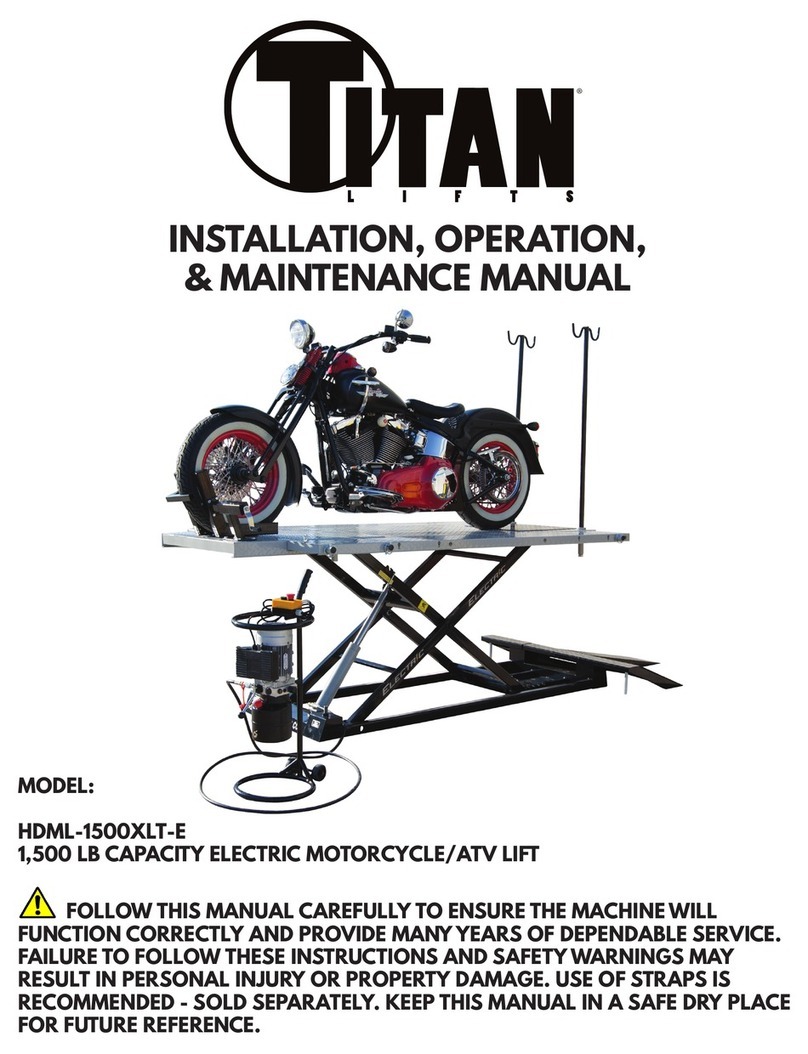
Titan Lifts
Titan Lifts HDML-1500XLT-E Instruction manual

Titan Lifts
Titan Lifts HD2P-9000AF Instruction manual

Titan Lifts
Titan Lifts HD2P-12000F Instruction manual

Titan Lifts
Titan Lifts HD2P-10000AC-D Instruction manual

Titan Lifts
Titan Lifts RJ-6K-HP Instruction manual

Titan Lifts
Titan Lifts MD-1250-XL Instruction manual
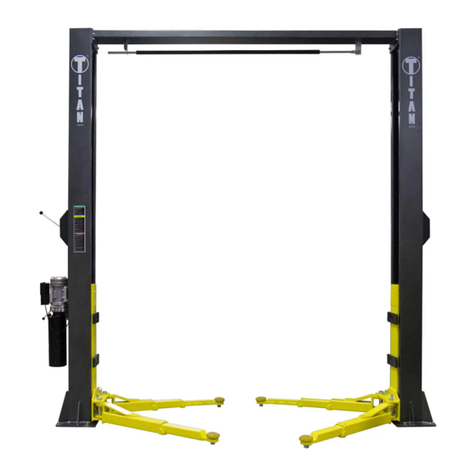
Titan Lifts
Titan Lifts PREMIER Series Instruction manual

Titan Lifts
Titan Lifts MASTER HD2P-9KMSC Instruction manual
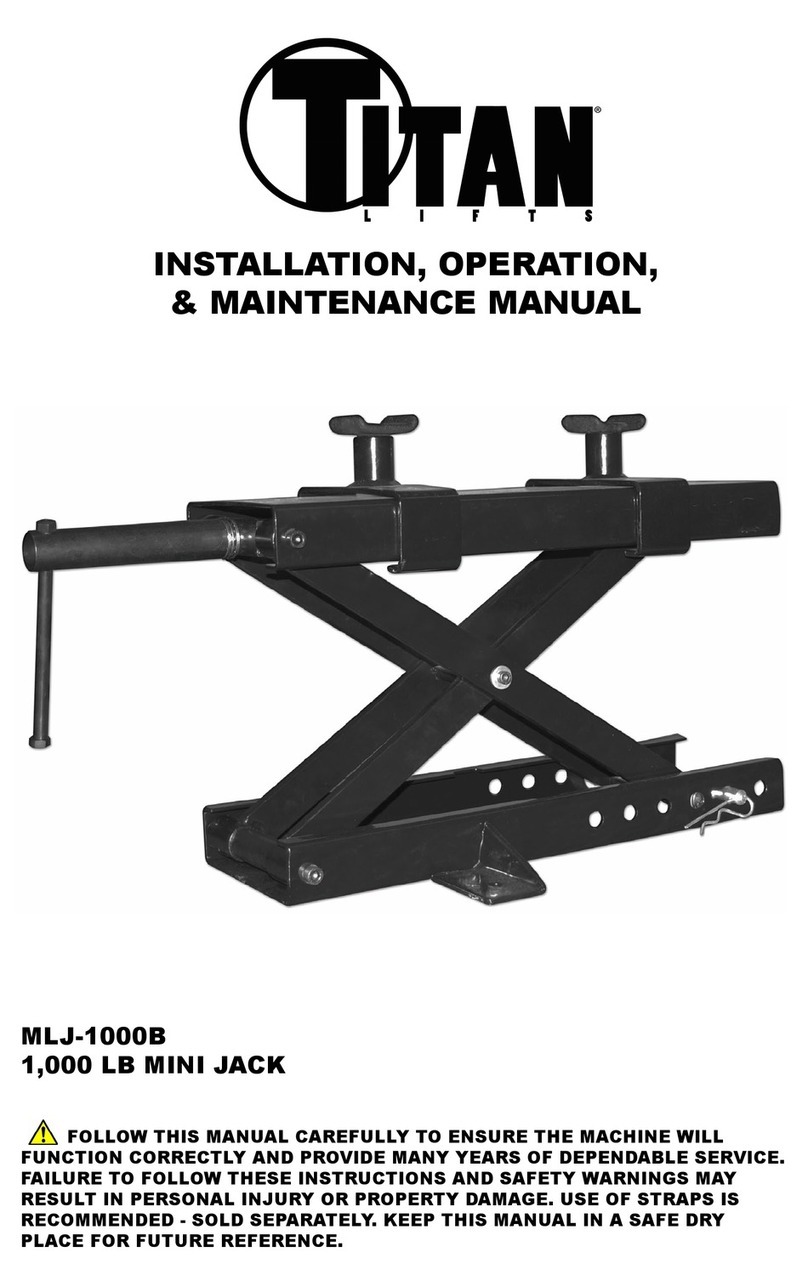
Titan Lifts
Titan Lifts MLJ-1000B Instruction manual

